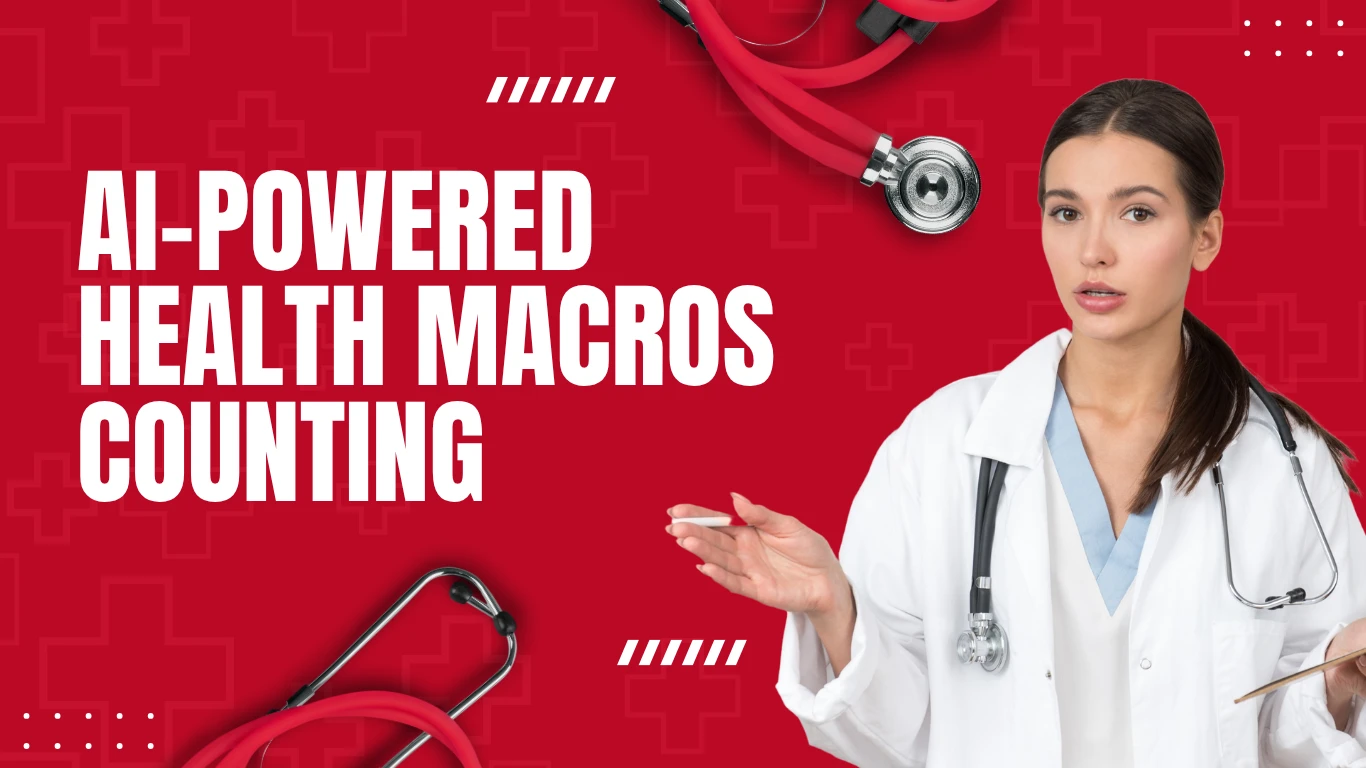Macros counting
Achieving individualized body goals involves great attention to what is consumed. One key in accomplishing that, macros counting, or measuring Macronutrients, allows individuals to efficiently monitor and control their diet.
As health monitoring with the help of artificial intelligence is becoming prevalent, macronutrient tracking has proven accurate and immediate. Macronutrient tracking helps individuals precisely monitor their intake of food, thereby ensuring that they achieve optimal levels of fitness.
Using cutting-edge technologies allows people to now make wise dietary decisions based on macronutrient intake, therefore optimizing their chances of good health. This blending of diet and technology is transforming our approach to individualized fitness.
The Science of Macronutrients and Why They Matter
Energy generation, recuperation, and general body composition all depend on Macronutrients in great part. Effective macronutrient tracking and nutritional analysis depend on a knowledge of their purposes and relevance.
Explaining Fats, Carbohydrates, and Proteins
The muscle builders, proteins, are also tasked with muscle building and repair. The most important source of energy is carbohydrates; lipids have a totally essential function in the synthesis of hormones and the utilization of nutrients. Each macronutrient does something specific and thus its Macros counting is most important in order to get optimal health.
Ratios Suitable for Various Body Constitutions
Body type, exercise level, and health goals also determine the optimal ratio of proteins, carbs, and fats. Athletes, for example, might need more protein to aid in muscle repair and growth.
Macros Affect Body Composition, Recovery, and Energy, Too
Macronutrients directly control body composition, energy, add exercise recovery. While an imbalance may cause fatigue or unwanted changes in body composition, balanced consumption allows for maximum energy production and aids in Macros counting
More importantly than their number are macronutrient quality. Emphasizing whole foods, lean proteins, and good fats guarantees that the body gets the required nutrients for best operation, thereby stressing the need of health monitoring and tailored diet.
Traditional Macro Tracking: Methods and Limitations
For a long time, tracking macros has been a manual and often cumbersome process. Individuals have relied on various methods to monitor their macronutrient intake, each with its own set of challenges.
Manual Counting and Food Diaries
One of the earliest methods of macro tracking involved manual counting and maintaining food diaries. This approach required individuals to meticulously record every meal and snack, calculating the macronutrient content of each food item. While effective for some, this method was often time-consuming and prone to human error.
First-Generation Digital Tracking Tools
The advent of digital tools simplified macro tracking to some extent. Early fitness tracking apps and software allowed users to log their food intake more efficiently. However, these tools often relied on databases that were not always up-to-date or comprehensive.
Despite the convenience offered by digital tools, Macros counting consistency remains a significant challenge. Users often struggle with accurately logging their intake, leading to inconsistent tracking and unreliable data.
| Method | Advantages | Limitations |
| Manual Counting | High accuracy if done correctly | Time-consuming, prone to human error |
| First-Generation Digital Tools | Easier to use than manual counting | Limited database, may lack specific foods |
Overall, traditional macro tracking methods have significant limitations that can hinder their effectiveness in achieving fitness and nutritional goals.
AI-Powered Health Tracking: The Future of Personalized Fitness
Machine learning algorithms are at the forefront of a new era in health tracking, offering unprecedented insights into nutritional analysis. This technological advancement is pivotal in shaping the future of personalized fitness and nutrition.
Machine Learning Algorithms in Nutritional Analysis
AI nutrition platforms utilize sophisticated machine learning algorithms to analyze vast amounts of nutritional data. These algorithms can identify patterns and correlations that may elude human analysts, providing personalized health recommendations tailored to an individual’s unique needs and goals.
Predictive Modeling for Dietary Outcomes
Predictive modeling is another critical component of AI-powered health tracking. By analyzing historical data and real-time inputs, these models can forecast dietary outcomes and suggest adjustments to optimize nutritional insights and Macros counting overall health.
Case Studies: Success Stories with AI Nutrition Platforms
Several case studies highlight the effectiveness of AI nutrition platforms. For instance, a study on athletes using AI-powered nutrition planning showed significant improvements in performance and recovery. The table below summarizes the findings:
| Athlete Group | Performance Improvement | Recovery Time Reduction |
| AI Nutrition Group | 15% | 20% |
| Control Group | 5% | 10% |
The integration of AI in health tracking is revolutionizing the way we approach personalized fitness and nutrition. By leveraging machine learning algorithms and predictive modeling, individuals can achieve better health outcomes and improved performance.
Smart Technology Revolutionizing Food Macros counting
Innovative technologies are changing the landscape of food tracking, making it more accurate and user-friendly. The integration of smart technology in health and fitness is revolutionizing how we monitor and manage our dietary habits.
Computer Vision and Automated Food Recognition
One of the significant advancements in food tracking is the use of computer vision for automated food recognition. This technology allows for the identification of food types and portion sizes through images captured by smartphones or wearable devices.
Accuracy Rates and Technological Challenges
While computer vision has shown promising results, there are challenges to overcome, such as varying lighting conditions and food presentation. The accuracy rates are improving with advancements in machine learning algorithms.
Voice-Activated Logging and Smart Kitchen Devices
Voice-activated logging is another innovation making food tracking more convenient. Users can log their meals using voice commands, reducing the need for manual entry. Additionally, smart kitchen devices can track cooking ingredients and portion sizes automatically.
Key benefits of these technologies include:
- Increased accuracy in food tracking
- Enhanced user experience through convenience
- Better data for personalized nutrition recommendations
Personalized Macro Recommendations Through Data Analysis
Personalized macro recommendations have become more accurate and accessible thanks to advancements in AI-driven health tracking. This development is largely attributed to the ability of AI systems to analyze vast amounts of biometric data, providing insights that can be used to tailor nutritional plans to individual needs.
Biometric Inputs That Shape AI Recommendations
AI-powered health tracking relies heavily on biometric inputs to generate personalized macro recommendations. These inputs include heart rate variability, sleep patterns, and activity levels. By analyzing these data points, AI systems can identify trends and patterns that inform nutritional advice.
The table below illustrates the types of biometric data used in AI-driven nutritional planning and their significance.
| Biometric Data | Significance in Nutritional Planning |
| Heart Rate Variability | Indicates stress levels and recovery status |
| Sleep Patterns | Affects metabolic rate and recovery |
| Activity Levels | Determines caloric needs and macro balance |
Adaptive Macros counting Programming Based on Progress Tracking
One of the key advantages of AI in nutritional planning is its ability to adapt recommendations based on progress tracking. As users’ biometric data changes over time, the AI system adjusts their macro recommendations to ensure they remain on track to meet their fitness goals.
How AI Detects Patterns Humans Miss
AI’s capability to analyze large datasets Macros counting allows it to detect subtle patterns that may elude human observers. This includes identifying correlations between different biometric inputs and nutritional outcomes, enabling more precise and effective macro recommendations.
By leveraging these advanced analytical capabilities, AI-powered health tracking systems provide a more nuanced and responsive approach to personalized fitness and nutrition planning.
Real-Time Nutritional Feedback Systems
The advent of real-time nutritional feedback systems is revolutionizing the way we approach health monitoring and nutritional insights. These systems provide immediate data on how our bodies respond to different foods and nutrients, enabling more informed dietary choices.
Continuous Glucose Monitoring Integration
One of the key features of real-time nutritional feedback is the integration of continuous glucose monitoring (CGM). CGM technology allows individuals to track their glucose levels throughout the day, providing valuable nutritional insights into how specific foods affect their blood sugar.
- Identifies glucose spikes and dips
- Helps in making informed dietary adjustments
- Enhances understanding of personal glucose responses
Behavioral Nudges and Smart Notifications
Real-time nutritional feedback systems also incorporate behavioral nudges through smart notifications. These nudges encourage healthier eating habits by reminding users of their nutritional goals and providing timely suggestions.
Psychological Impact of Immediate Feedback
The immediate feedback provided by these systems has a significant psychological impact. It fosters a sense of control and motivation, as users can directly correlate their food choices with their bodily responses.
Holistic Health Tracking: Beyond Just Macros counting
The pursuit of optimal health necessitates a broader perspective, one that encompasses various aspects beyond just macronutrient tracking. Holistic health tracking involves monitoring a range of health metrics to provide a comprehensive view of an individual’s well-being.
Sleep, Stress, and Recovery Metrics
Key components of holistic health tracking include monitoring sleep quality, stress levels, and recovery metrics. These factors significantly impact overall health and can be influenced by nutritional intake. Advanced health tracking technologies now allow for the integration of these metrics, providing a more nuanced understanding of how different aspects of health interrelate.
Performance Correlation with Nutritional Intake
By analyzing the correlation between nutritional intake and performance metrics, individuals can gain insights into how their diet affects their energy levels, workout performance, and recovery. This information can be used to make informed adjustments to their nutrition plan.
Creating Sustainable Lifestyle Changes
The ultimate goal of holistic health tracking is to facilitate sustainable lifestyle changes. By considering a broad range of health metrics and their interrelations, individuals can adopt a more balanced approach to health and wellness. This comprehensive approach supports long-term success and overall well-being.
Scientific Validation of AI Nutritional Approaches
Recent studies have focused on validating the scientific basis of AI-driven nutritional approaches. The growing interest in personalized nutrition has led to an increase in clinical studies examining the effectiveness of AI in dietary planning.
Clinical Studies on Algorithm-Based Nutrition Plans
Several clinical studies have investigated the efficacy of algorithm-based nutrition plans. These studies typically assess the impact of AI-driven dietary recommendations on various health outcomes, such as weight management and improved nutritional balance. For instance, a study might compare the outcomes of participants following AI-generated meal plans against those adhering to traditional dietary advice.
Comparing AI Recommendations to Registered Dietitians
Another area of research involves comparing the recommendations made by AI systems with those provided by registered dietitians. Preliminary findings suggest that AI can offer highly personalized and effective nutritional advice, often rivaling the quality of recommendations made by human experts. However, the accuracy of AI recommendations depends heavily on the quality of the data it is trained on.
Limitations in Current Research
Despite the promising results, there are limitations to the current research. One significant challenge is the variability in data quality used to train AI algorithms. Additionally, more extensive clinical trials are needed to fully validate the long-term efficacy and safety of AI-driven nutritional approaches.
The scientific validation of AI nutritional approaches is an evolving field that holds significant promise for personalized health and wellness. As research continues to emerge, it is likely that AI will play an increasingly important role in nutritional analysis and dietary planning.
Overcoming Adherence Challenges with Smart Solutions
The key to successful fitness tracking lies in overcoming adherence challenges with intelligent approaches. Fitness tracking apps have evolved to incorporate features that make the tracking process more engaging and sustainable.
Gamification Elements in Tracking Apps
Gamification is a powerful tool used in fitness tracking apps to boost user engagement. By incorporating elements like rewards, challenges, and leaderboards, these apps make the tracking process more enjoyable and interactive. For instance, apps like MyFitnessPal and Fitbit use gamification to encourage users to reach their daily step goals or log their meals consistently.
Social Support and Community Features
Social support is another critical factor in maintaining adherence to fitness tracking. Many apps now offer community features that allow users to connect with like-minded individuals, share progress, and participate in group challenges. This sense of community fosters accountability and motivation, helping users stay on track with their fitness goals.
Habit Formation Through Technological Assistance
Technological assistance plays a significant role in habit formation. Fitness tracking apps use various strategies, such as reminders, personalized coaching, and habit tracking, to help users develop consistent habits. By leveraging these features, users can create a sustainable routine that supports their long-term fitness objectives.
Data Security and Ethical Considerations
As AI-powered health tracking becomes increasingly prevalent, concerns regarding data security and ethical considerations have come to the forefront. The sensitive nature of health information necessitates robust protection measures.
Protecting Sensitive Health Information
AI-powered health tracking involves the collection and analysis of highly personal data. Ensuring the security of this information is paramount. This can be achieved through advanced encryption methods and secure data storage solutions.
The following table highlights key measures for protecting sensitive health information:
| Security Measure | Description | Benefit |
| Data Encryption | Encoding data to prevent unauthorized access | Protects user data from breaches |
| Secure Authentication | Verifying user identity through multiple factors | Prevents unauthorized access to user accounts |
| Regular Security Audits | Periodic examination of security protocols | Identifies and addresses potential vulnerabilities |
Transparency in Algorithm Development
Transparency in how AI algorithms are developed and function is crucial for building trust among users. This involves being open about the data used to train algorithms and how they impact recommendations.
User Ownership of Personal Health Data
Users should have control over their personal health data, including the ability to access, modify, and delete their information. This principle is fundamental to ethical AI-powered health tracking.
By prioritizing data security and ethical considerations, AI-powered health tracking can provide a safe and trustworthy environment for users to monitor and manage their health.
The Next Frontier: Emerging Technologies in Nutrition Tracking
The landscape of nutrition tracking is on the cusp of a revolution, driven by emerging health technologies that promise to redefine our understanding of dietary health. These advancements are not only enhancing the precision of nutritional analysis but are also making it more accessible and personalized.
Implantable and Non-Invasive Monitoring Devices
One of the most significant developments in nutrition tracking is the emergence of implantable and non-invasive monitoring devices. These devices can continuously track various health metrics, providing real-time data on an individual’s nutritional status and health outcomes. For instance, continuous glucose monitoring systems have become increasingly popular among individuals with diabetes, offering insights into how different foods affect blood glucose levels.
Genetic and Microbiome Analysis Integration
The integration of genetic and microbiome analysis into nutrition tracking represents a significant leap forward. By understanding an individual’s genetic predispositions and the composition of their microbiome, it’s possible to tailor dietary recommendations that are more likely to be effective. This personalized approach to nutrition is revolutionizing the way we think about diet and health.
Predictive Health Modeling and Preventative Nutrition
Predictive health modeling, powered by advanced algorithms and machine learning, is enabling a proactive approach to nutrition and health. By analyzing data from various sources, including genetic information, dietary habits, and health outcomes, these models can predict an individual’s risk of developing certain health conditions. This allows for the implementation of preventative nutrition strategies, potentially reducing the risk of chronic diseases.
| Technology | Application | Benefit |
| Implantable Monitoring Devices | Continuous Health Metric Tracking | Real-time Nutritional Insights |
| Genetic Analysis | Personalized Dietary Recommendations | Enhanced Health Outcomes |
| Predictive Health Modeling | Risk Assessment for Health Conditions | Preventative Nutrition Strategies |
Conclusion: Embracing AI for Sustainable Nutritional Success
The integration of AI in health tracking has transformed the landscape of personalized fitness and sustainable nutrition. By leveraging AI-powered health tracking, individuals can now receive tailored nutritional recommendations that cater to their unique needs and goals.
This approach not only enhances the effectiveness of dietary plans but also promotes long-term adherence, a crucial factor in achieving sustainable nutritional success. As technology continues to evolve, the potential for AI to further personalize fitness and nutrition strategies is vast.
Embracing AI-driven solutions can lead Macros counting to more informed decision-making and a more streamlined approach to health and wellness. By adopting these innovative tools, individuals can take a significant step towards achieving their personalized fitness goals and maintaining a balanced, sustainable nutrition plan.
FAQ
Macronutrient tracking involves monitoring the intake of proteins, carbohydrates, and fats to achieve personalized fitness goals. It is crucial because it helps in optimizing energy, recovery, and body composition.
AI-powered health tracking systems use machine learning algorithms to analyze nutritional data, providing insights into dietary outcomes and personalized recommendations.
Traditional macro tracking methods, such as manual counting and using first-generation digital tools, can be challenging to maintain consistently due to their tedious nature and lack of personalization.
Computer vision technology automates food recognition, making it easier to track nutritional intake accurately. However, it faces challenges related to accuracy rates and technological limitations.






